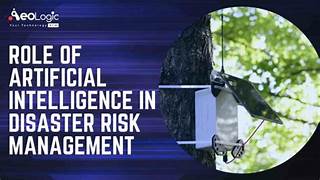The Role of AI in Improving Disaster Response and Recovery
Natural disasters and crises are unpredictable and devastating, often leaving communities in chaos. The rapid escalation of climate change and urbanization has further intensified the frequency and impact of these events. Artificial Intelligence (AI), with its powerful analytical and predictive capabilities, is emerging as a transformative tool in disaster response and recovery. By enhancing preparedness, streamlining response efforts, and aiding in recovery, AI holds the potential to save lives, minimize economic loss, and build more resilient societies.
AI in Disaster Preparedness
The effectiveness of disaster response begins with preparation. AI is instrumental in improving early warning systems and forecasting capabilities, which are critical for mitigating the impact of disasters.
1. Predictive Analytics
AI leverages vast datasets, including satellite imagery, weather data, and historical disaster records, to predict the likelihood and severity of future disasters. For instance:
- Hurricane Forecasting: AI models analyze meteorological data to predict storm trajectories and intensity, enabling timely evacuation plans.
- Flood Risk Assessment: Machine learning algorithms identify areas prone to flooding by analyzing rainfall patterns, topography, and drainage systems.
2. Early Warning Systems
AI-powered systems can issue alerts with unprecedented accuracy. For example:
- Earthquake Detection: Seismic sensors combined with AI algorithms can detect early tremors and provide seconds to minutes of warning.
- Wildfire Monitoring: AI processes real-time data from satellites and sensors to identify and predict the spread of wildfires.
3. Scenario Planning
AI-driven simulations help governments and organizations prepare for disaster scenarios by:
- Modeling potential disaster impacts.
- Identifying vulnerabilities in infrastructure and supply chains.
- Optimizing resource allocation for emergency response.
AI in Disaster Response
When disaster strikes, rapid and coordinated response efforts are essential. AI aids in real-time decision-making, resource allocation, and communication during crises.
1. Damage Assessment
AI-powered drones and satellites provide real-time imagery and data, enabling quick assessment of affected areas. This helps:
- Identify the most severely impacted regions.
- Prioritize rescue and relief operations.
- Estimate infrastructure damage for immediate repair efforts.
2. Search and Rescue Operations
AI enhances search and rescue missions through:
- Image Recognition: AI systems analyze drone footage to identify survivors in debris or inaccessible areas.
- Robotic Assistance: AI-powered robots navigate hazardous environments, delivering supplies or assisting trapped individuals.
3. Resource Allocation
AI ensures efficient use of limited resources by:
- Predicting demand for food, water, and medical supplies in different areas.
- Optimizing logistics for delivery of aid.
- Allocating emergency personnel based on real-time needs.
4. Communication and Coordination
AI-powered chatbots and platforms facilitate communication during crises by:
- Providing real-time updates to the public.
- Coordinating efforts among government agencies, NGOs, and volunteers.
- Translating languages to assist in international disaster response efforts.
AI in Disaster Recovery
The recovery phase is critical for restoring normalcy and building resilience against future disasters. AI contributes significantly to rebuilding efforts and long-term planning.
1. Damage Analysis and Reconstruction
AI helps prioritize rebuilding efforts by:
- Analyzing structural damage to determine repair or reconstruction needs.
- Identifying critical infrastructure that requires immediate attention.
- Optimizing resource distribution for reconstruction projects.
2. Economic Recovery
AI aids in assessing economic losses and devising recovery strategies by:
- Analyzing data on affected industries and employment trends.
- Providing insights for government aid distribution and economic stimulus plans.
- Identifying opportunities for rebuilding more resilient economies.
3. Mental Health Support
AI-driven mental health platforms provide psychological support to disaster survivors by:
- Offering virtual counseling services.
- Monitoring mental health trends in affected populations.
- Providing resources for coping and recovery.
4. Resilience Building
AI promotes long-term resilience by:
- Identifying patterns in disaster impacts to inform urban planning.
- Enhancing infrastructure design to withstand future disasters.
- Supporting community education and preparedness initiatives.
Challenges in Implementing AI for Disaster Management
While AI has transformative potential, its application in disaster response and recovery faces several challenges:
1. Data Limitations
- Incomplete or biased datasets can reduce the accuracy of AI predictions.
- Real-time data collection in disaster zones can be challenging due to infrastructure damage.
2. Technical Barriers
- Limited access to advanced AI tools and infrastructure in developing regions.
- High costs associated with deploying AI technologies.
3. Ethical Concerns
- Ensuring data privacy and security, especially in sensitive situations.
- Avoiding over-reliance on AI at the expense of human judgment and empathy.
4. Coordination and Collaboration
- Integrating AI systems with existing disaster management frameworks requires collaboration among multiple stakeholders.
- Resistance to adopting new technologies can hinder progress.
The Future of AI in Disaster Management
Advancements in AI and related technologies hold promise for overcoming these challenges. The future of AI in disaster management includes:
1. Enhanced Real-Time Analysis
AI models capable of processing data from multiple sources simultaneously will enable faster and more accurate decision-making during crises.
2. Personalized Alerts
AI systems could deliver tailored alerts based on individual locations, needs, and vulnerabilities, improving the effectiveness of early warning systems.
3. Global Collaboration
AI-driven platforms could facilitate international cooperation by sharing data, resources, and best practices across borders.
4. Community Engagement
AI can empower communities by providing accessible tools for disaster preparedness, response, and recovery, fostering resilience from the ground up.
Conclusion
AI is revolutionizing disaster response and recovery, offering unprecedented opportunities to save lives, reduce economic losses, and build resilient communities. By enhancing preparedness, optimizing response efforts, and supporting recovery, AI is transforming how humanity confronts natural and man-made disasters. However, realizing its full potential requires addressing technical, ethical, and logistical challenges. With continued innovation, collaboration, and investment, AI can become a cornerstone of effective disaster management, ensuring a safer and more resilient future for all.


